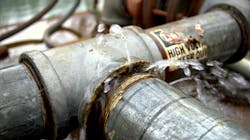Developing a Water Management Strategy for Drought and Fire Season
The year 2020 was truly devastating for wildfires. From California to Australia, the world got a firsthand glimpse into how warmer, drier conditions are enabling harsher periods of drought – resulting in longer fire seasons and greater water scarcity.
Significantly, more than 10.3 million acres were burned in 2020, compared to 4.7 million acres the previous year. These numbers, coupled with warnings of rising temperatures and increased droughts, present a harsh reality for utilities. The pressure is on to make every drop of water count. Preventing water loss before it reaches the end-user, also known is non-revenue water loss, is more critical now than ever.
One analysis by Frost & Sullivan shows nearly one-third of all water is lost before reaching a customer. It is estimated that about 126 billion liters and $39 billion of non-revenue water is lost annually. The resulting scarcity of water amidst these losses plagues utilities and the communities they serve year-round. The stakes are even higher during drought and fire season, as water scarcity and lower water pressure could result in prolonged wildfires.
Simply put, water utilities must be equipped to monitor and respond to potential threats to their supply in real time, to combat non-revenue water loss and protect their communities. Fortunately, technology is in a place today to support these efforts and even help enable greater conservation overall.
Internet of Things (IoT) and Edge Intelligence
Asset management is among the most pressing challenges for water utilities, as most water transportations systems are more than 60 years old and largely underground. This makes these antiquated systems very difficult and expensive to maintain. According to the American Water Works Association, it will cost about $1 trillion over the next 25 years to meet U.S. demands for safe drinking water. Further, at least $271 billion more will likely be needed to support the 56 million-plus new users who will be connected to centralized treatment systems over the next two decades as a result of urbanization. Our infrastructure is on borrowed time—leading to a mounting urgency to have more granular insights about water operations management challenges in as real time as possible. Herein lies the opportunity with IoT and edge intelligence.
IoT sensors placed “on the edge” can make decisions on locally harvested data spanning across the water continuum powered by edge intelligence, or decentralized processing power that gathers information in near-real time, help identify physical loss in the form of leaks or even theft by “listening” for the sound frequency of water passing through pipes to know where it’s going. The technology can then use advanced algorithms to identify these trouble spots and enable utilities to react quickly with corrective action.
Having this deep understanding of where failures in the infrastructure are taking place allows utilities to minimize overall costs and service disruptions. This can limit the need for emergency after-hours responses and can decrease response times to minimize water loss when leaks do occur. Further, with regards to drought and fire season, IoT also enables a 24/7 view into water reserves and the readiness of water infrastructure to support fire departments during wildfires.
Data Modeling & Simulation
Data models based on current and historical data can help utilities better manage water resources and identify ways to reduce use by equipping them with a baseline. From there, identifying excessive water usage can help with the earlier flagging of potential leaks behind the meter and provide intelligence on larger-scale inefficiencies. These insights enable utilities to improve the overall customer experience and optimize revenue streams while reducing water waste and improving water accessibility.
Additionally, data modeling can help utilities to disaggregate water loss and therefore determine where and how water is being lost. For example, leak sensors installed on the water service pipe can analyze sound patterns every day detecting new, evolving and pre-existing leaks automatically. This aggregated data highlights the status and location of possible leaks. Over time, the expanding database of historical sensor information provides a comprehensive condition assessment of the entire water distribution system, helping utilities proactively mitigate water loss.
Utilities can also identify whether water access is being thwarted by theft and whether water usage is being billed correctly. With this information in hand, the utility can explore these losses to help curtail theft or misuse. In the grander scheme, this practice serves to maximize resources and ensure every drop of water is accounted for.
Digital Twin
As water scarcity concerns increase, it’s more important than ever to ensure network optimization. Data-driven planning is critical, and for this reason, digital twins, or software representations of assets and processes, are valuable for identifying leaks and helping with seasonal demand fluctuations.
Building a digital twin of a water system allows utilities to develop and train data models to understand and prepare for peaks and troughs of water demand, a critical element of urban water resource planning and management.
Further, most dry regions rely on supplementing their own water resources with water purchased from other regions. This alone can be costly and compounded by water loss and in times of water scarcity. In this instance, a digital twin can apply historical knowledge to data models to predict water availability, help manage storage, and forecast water costs.
Conclusion
Water conservation is pertinent for the months to come as we head into drought and wildfire season. It has also become a constant need as drinking water around the world becomes an increasingly precious commodity. Water management is critically important to prevent and to help fight fires. On top of this, water scarcity is a growing problem afflicting communities around the globe.
It’s our responsibility, not only as an industry but as global citizens, to solve the crisis of non-revenue water loss. The current infrastructure is in dire straits, and climate change is not going away. Knowing this, we must be willing to innovate our approach to management with technology if we want to protect the world’s most precious resource for this generation and for future generations to come.
About the Author: Jeff McCracken is Director, Operations Management Outcomes with Itron.
About the Author

Jeff McCracken
Jeff McCracken, director of operations management outcomes, provides global leadership for software and services solutions that incorporate big data technology, industry expertise and advanced algorithms to deliver business intelligence and predictive analytics to Itron’s utility customers. He oversees the discovery and validation of market opportunity and market use cases; and drives go-to-market strategy ensuring strategic positioning, allowing the utility to achieve maximum value from their smart grid, smart water or smart gas investment.
